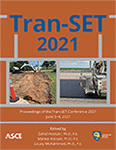Tran-SET 2021
Vacuum Impregnation of Bacillus pseudofirmus into Fine Lightweight Aggregate
Publication: Tran-SET 2021
ABSTRACT
Bacterial concrete is one of the most promising self-healing alternatives due to its ability to seal crack widths through microbial induced calcite precipitation (MICP). In this process, alkali-resistant Bacillus pseudofirmus bacteria are embedded in concrete to precipitate calcium carbonate to seal the cracks. Due to concrete’s harsh environment, it is critical to protect the bacteria to ensure the viability of this technology. One of the key protection techniques is vacuum impregnation into porous aggregates. The objective of this study was to evaluate the impregnation efficiency of Bacillus pseudofirmus into fine lightweight aggregate by using three different nutrients, namely, magnesium acetate, calcium lactate, and sodium lactate by using a vacuum impregnation chamber. To achieve this objective, a vacuum impregnation chamber was used to impregnate Bacillus pseudofirmus bacteria at a concentration of 108 cells/ml into three fine lightweight aggregate samples. In these samples, three different nutrients namely, magnesium acetate; calcium lactate; and sodium lactate were added to yeast extract and impregnated at a concentration of 75 mM/l along with the bacteria. Eventually, Scanning Electron Microscope with Energy Dispersive Spectroscopy analysis (SEM-EDS analysis) was conducted to evaluate the impregnation efficiency of the bacteria into the three aggregate samples. The results indicated that the bacteria were successfully impregnated into all the aggregate samples. Future work will be conducted in this study to evaluate the pre-cracking strength recovery and crack sealing efficiency for the different nutrients.
Get full access to this article
View all available purchase options and get full access to this chapter.
REFERENCES
ASCE's 2017 American Infrastructure Report Card | GPA: D+. ASCE's 2017 Infrastructure Report Card. (2017). Accessed January 23, 2021, from https://www.infrastructurereportcard.org/.
Alghamri, R., Kanellopoulos, A., Al-Tabbaa, A. (2016). Impregnation and encapsulation of lightweight aggregates for self-healing concrete. Construction and Building Materials, 124, 910–921. https://doi.org/10.1016/j.conbuildmat.2016.07.143
Cui, H. Z., Lo, T. Y., Memon, S. A., Xu, W. (2012). Effect of lightweight aggregates on the mechanical properties and brittleness of lightweight aggregate concrete. Construction and Building Materials, 35, 149–158. https://doi.org/10.1016/j.conbuildmat.2012.02.053
De Belie, N. (2016). Application of bacteria in concrete: a critical evaluation of the current status. RILEM Technical Letters, 1, 56. https://doi.org/10.21809/rilemtechlett.2016.14
Huang, H., Ye, G., Qian, C., Schlangen, E. (2016). Self-healing in cementitious materials: Materials, methods and service conditions. Materials and Design, 92, 499–511. https://doi.org/10.1016/j.matdes.2015.12.091
Nasrazadani, S., Hassani, S. (2016). Modern analytical techniques in failure analysis of aerospace, chemical, and oil and gas industries. Handbook of Materials Failure Analysis with Case Studies from the Oil and Gas Industry, 39–54. https://doi.org/10.1016/B978-0-08-100117-2.00010-8
Paultre, A. L. (2003). Ad astra per aspera. In Electronic Products (Garden City, New York)(Vol. 45, Issue 10).
Saran, A. S. A., Magudeswaran, P. (2017). SEM Analysis on Sustainable High Performance Concrete. International Journal of Innovative Research in Science, Engineering and Technology, 6(6), 11. https://doi.org/10.15680/IJIRSET.2017.0606016
Soysal, A., Milla, J., King, G. M., Hassan, M., Rupnow, T. (2020). Evaluating the Self-Healing Efficiency of Hydrogel-Encapsulated Bacteria in Concrete. Transportation Research Record, 2674(6), 113–123. https://doi.org/10.1177/0361198120917973
Wang, J. Y., De Belie, N., Verstraete, W. (2012). Diatomaceous earth as a protective vehicle for bacteria applied for self-healing concrete. Journal of Industrial Microbiology and Biotechnology, 39(4), 567–577. https://doi.org/10.1007/s10295-011-1037-1
Wiktor, V., Jonkers, H. M. (2011). Quantification of crack-healing in novel bacteria-based self-healing concrete. Cement and Concrete Composites, 33(7), 763–770. https://doi.org/10.1016/j.cemconcomp.2011.03.012
Information & Authors
Information
Published In
Tran-SET 2021
Pages: 365 - 372
Editors: Zahid Hossain, Ph.D., Arkansas State University, Marwa Hassan, Ph.D., Louisiana State University, and Louay Mohammad, Ph.D., Louisiana State University
ISBN (Online): 978-0-7844-8378-7
Copyright
© 2021 American Society of Civil Engineers.
History
Published online: Nov 17, 2021
Published in print: Nov 17, 2021
Authors
Metrics & Citations
Metrics
Citations
Download citation
If you have the appropriate software installed, you can download article citation data to the citation manager of your choice. Simply select your manager software from the list below and click Download.
